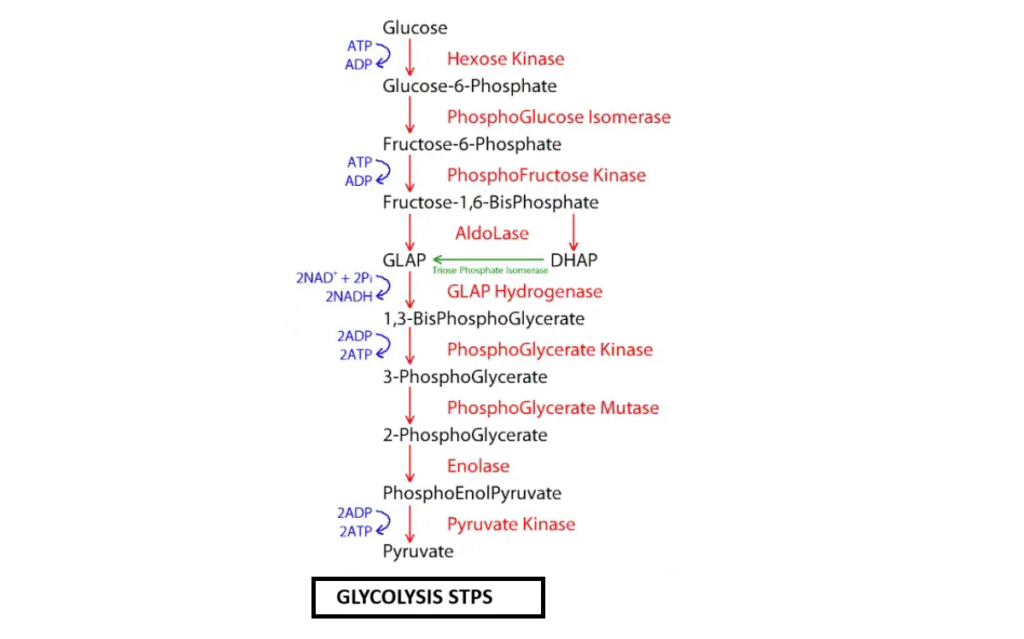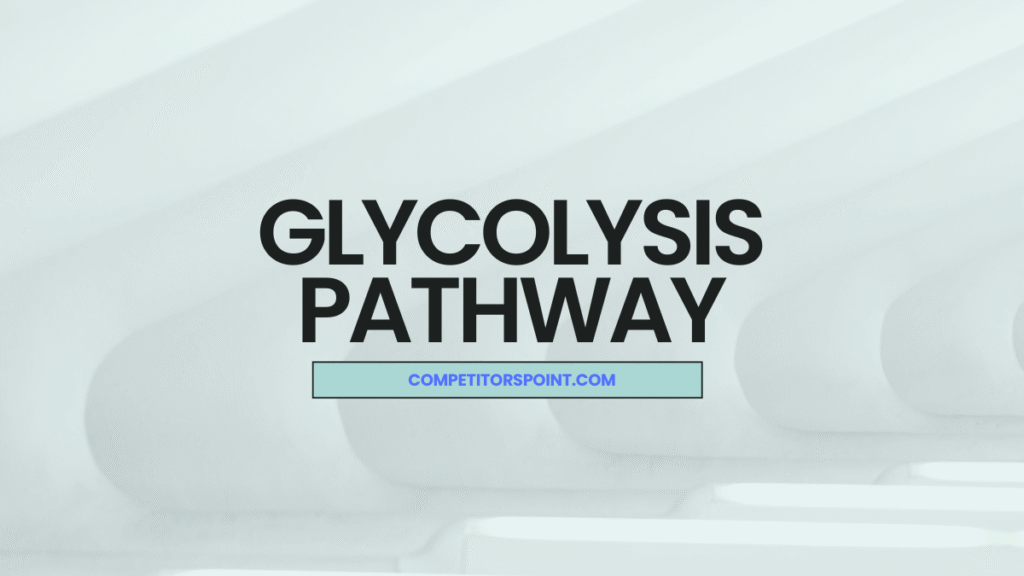The following article provides a detailed overview of glycolysis, a fundamental metabolic pathway in plants and other organisms. It covers the location of glycolysis within the cell, its two main phases (energy-spending and energy-conserving), the reversible and irreversible reactions involved, and the utilization of glucose and fructose. Each step of glycolysis is explained in detail, including the enzymes involved and the products formed. The following article also clarifies the net ATP production in both anaerobic and aerobic pathway.
Introduction
Both plants and animals require energy, which is generated through the process of respiration. Respiration involves the intake of oxygen. Unlike animals, plants do not have specialized respiratory organs like lungs. This is because plants have lower energy requirements compared to animals, and the exchange of gases occurs primarily on the plant surface. Plants also produce oxygen through photosynthesis.
The process of respiration involves the formation of energy through oxidation, an exothermic process. This process results in the formation of two types of energy carriers:
-
ATP (Adenosine Triphosphate): Formed through substrate-level phosphorylation, ATP is a direct source of energy that can be readily used by the cell.
-
NADH (Nicotinamide Adenine Dinucleotide): NADH stores electrons that will be used later to generate energy.
Glycolysis / EMP Pathway
Glycolysis is a metabolic pathway that breaks down one molecule of glucose into two molecules of pyruvate, generating ATP and NADH in the process. It occurs in both prokaryotic and eukaryotic cells. The site of glycolysis is the cytoplasm of the cell.

Glycolysis Phases
Glycolysis is divided into two main phases:
-
Energy-Spending Phase (Preparatory Phase): This phase consists of the first five steps of the pathway. Energy in the form of ATP is consumed to phosphorylate glucose and convert it into a form that can be readily cleaved into two three-carbon molecules. This phase is also known as the glucose activation phase because it prepares the glucose molecule for subsequent breakdown.
-
Energy-Conserving Phase (Payoff Phase): This phase comprises the last five steps of glycolysis. During this phase, the two three-carbon molecules generated in the preparatory phase are further processed to produce ATP and NADH. This phase is also known as the payoff phase because it generates energy for the cell.
Irreversible and Reversible Reactions
Out of the 10 steps of glycolysis, three reactions are irreversible, while the remaining seven are reversible. The irreversible reactions are:
-
Step 1: Phosphorylation of glucose to glucose-6-phosphate by hexokinase.
-
Step 3: Phosphorylation of fructose-6-phosphate to fructose-1,6-bisphosphate by phosphofructokinase-1 (PFK-1).
-
Step 10: Conversion of phosphoenolpyruvate to pyruvate by pyruvate kinase
The irreversibility of these reactions ensures that the metabolic pathway proceeds in a unidirectional manner and allows for tight regulation of the pathway.
Decarboxylation
Glycolysis does not involve any decarboxylation reactions. Decarboxylation is the removal of a carbon dioxide (CO2) molecule from a substrate. In this pathway, the carbon atoms of glucose are conserved throughout the pathway and are ultimately incorporated into the pyruvate molecules.
Glucose and Fructose Utilization in Glycolysis
In plants, glucose is synthesized in leaf cells during photosynthesis. However, glucose is not the primary form of sugar transported throughout the plant. Instead, glucose is converted to sucrose, a disaccharide composed of glucose and fructose, for transport from the leaves to other parts of the plant, such as the roots.
In root cells, sucrose can be broken down into glucose and fructose by the enzyme invertase. Both glucose and fructose can then enter the glycolytic pathway to generate energy. Fructose enters glycolysis by being phosphorylated to fructose-6-phosphate, which is an intermediate in the pathway.
Steps in Glycolysis
Step 1
In this step, glucose is phosphorylated by ATP to form glucose-6-phosphate. The ATP releases one phosphate to activate one glucose molecule on its 6th carbon. When ATP is broken down to ADP, energy is released and that is used to activate the glucose molecule. The enzyme involved in this step is Hexokinase. Mg2+ is required for kinase activity.
Glucose + ATP --Hexokinase--> Glucose - 6P + ADP
Step 2
In this step, glucose-6-P is converted into Fructose-6-P. This process is called isomerization and the enzyme involved in this process is called Phospho-gluco-isomerase.
Glucose-6-Phosphate --Phospho-gluco-isomerase.--> Fructose-6-Phosphate
Step 3
In this step, one more phosphate is added at the first position of the Fructose-6-P to form Fructose 1,6 – bisphosphate. It means, another ATP is used in this process, the first ATP was used in the first step of glycolysis. Again, this process is called phosphorylation and the enzyme involved is called Phospho-fructo-kinase. Mg2+ is required for kinase activity.
Fructose-6-P + ATP --Phosphofructokinase--> Fructose 1,6-bisphosphate
Step 4
In this step, the 6C Fructose 1,6-bisphosphate splits into two 3C compounds, one with a ketone group and one with an aldehyde group. The 3C compound containing a ketone group is called Dihydroxyacetone phosphate (DiHAP), and the other 3C aldehyde group containing compound is called Phosphoglyceraldehyde (PGAL). This splitting of 6C compound into two 3C compounds is facilitated by an enzyme called ALDOLASE
Fructose 1,6-bisphosphate --Aldolase--> DiHAP + PGAL
Step 5
The DiHAP formed gets converted into PGAL and the next product would form from PGAL only. In other words, DiHAP will not form any new product instead, it gets converted into PGAL through a reversible reaction. It means, two molecules of PGAL would continue the next steps of glycolysis. This reversible reaction is facilitated by an enzyme called TRIOSE PHOSPHATE ISOMERASE.
DiHAP --Triose-P-isomerase--> PGAL
Step 6
In this step, the two molecules of PGAL undergo oxidation and form acids. When aldehyde is oxidized, it forms an acid. So, in this step, PGAL, which is an aldehyde undergoes oxidation to form 2 molecules of phosphoglyceric acid. In this process, oxidation occurs due to the reduction of NAD+ to NADH. During this oxidation process, one inorganic phosphorus (iP) gets attached to the acid to form 1,3-bisphosphoglycerate. Since, two acid molecules are formed, so, the final product of the sixth step of glycolysis is 2 molecules of 1,3-bisphosphoglyceric acid. The enzyme that facilitates this reaction is phosphoglycerate dehydrogenase.
(2) PGAL + 2iP + 2 NAD+ --phosphoglycerate dehydrogenase--> (2) 1,3-bisphosphoglycerate + (2) NADH
Step 7
In this step, the inorganic phosphate attached in step 6 will be released and get attach to the ADP+ molecule to form ATP. In other words, 2 molecules of 1,3-bisphosphoglyceric acid will be converted to 2 molecules of 3 phosphoglyceric acid and 2 molecules of ATP.
(2) 1,3-bisphosphoglycerate + 2ADP+ --PHOSPHOGLYCERATE KINASE--> (2) (3PGA) + 2 ATP
Step 8
In this step, the 3PGA isomerizes to form 2PGA. Since, there are two molecules of 3PGA, therefore, 2 molecules of 2PGA are formed. This reaction is facilitated by the enzyme MUTASE.
(2) 3PGA --MUTASE--> (2) 2PGA
Step 9
In this process, water molecule is removed from 2PGA to form Phosphoenolpyruvate (PEP). Since, there are two molecules of 2PGA, so, two molecules of water are removed.
(2) 2PGA --ENOLASE--> (2) PEP + 2 H20
Step 10
PEP is an unstable compound as it possesses high energy and thus, it readily converts into Pyruvic acid and the phosphate from PEP is removed to convert ADP to ATP. Again, since two molecules of PEP are converted into two molecules of pyruvate, two molecules of ATP are formed.
(2) PEP + 2 ADP + 2Pi --PYRUVATE KINASE--> (2) Pyruvate + 2 ATP
Net ATP Yield in Aerobic and Anaerobic Glycolysis
Anaerobic Glycolysis
Under anaerobic conditions (absence of oxygen), pyruvate is converted to lactate (lactic acid) in a process called fermentation. This regenerates NAD+, which is essential for glycolysis to continue.
-
ATP Yield: The net ATP yield in anaerobic glycolysis is solely the 2 ATP produced directly during glycolysis. The NADH produced during the pathway is used to reduce pyruvate to lactate, so it does not contribute to further ATP production.
In summary, anaerobic glycolysis yields a net of 2 ATP.
Aerobic Glycolysis
In the presence of oxygen, pyruvate enters the mitochondria and is converted to acetyl-CoA, which then enters the citric acid cycle (Krebs cycle). The NADH produced during glycolysis can also be utilized in the electron transport chain (ETC) within the mitochondria to generate additional ATP through oxidative phosphorylation.
-
NADH and the Electron Transport Chain: Each NADH molecule produced during glycolysis can yield approximately 3 ATP molecules in the ETC. Since glycolysis produces 2 NADH molecules, this can potentially generate 6 ATP molecules.
-
Total ATP Yield: The total ATP yield in aerobic glycolysis includes the 2 ATP produced directly during glycolysis, plus the ATP generated from the 2 NADH molecules in the ETC.
Therefore, the total ATP yield in aerobic glycolysis is 2 ATP (from glycolysis) + 6 ATP (from 2 NADH) = 8 ATP.
In summary, aerobic glycolysis yields a total of 8 ATP.
FAQs (Frequently Asked Questions)
Q. If glycolysis needs ATP in its early steps, how is that possible when the whole purpose of cellular respiration is to produce ATP? I’m confused about where those initial ATP molecules come from when the pathway uses them in steps like 1 and 3.
A. Your cells always keep a small supply of ATP on hand, even when they’re about to start breaking down glucose. Glycolysis doesn’t begin from zero.
Q. How can NADH be considered an energy-carrying molecule if making it already releases energy? Does it simply end up with less potential energy than the original G3P but still hold enough to power the electron transport chain later on?
A. When NADH forms, the reaction that creates it does release some energy, but not all of the energy from the electrons is lost. A good amount is captured and held by NADH in the form of high-energy electrons. Those electrons still have plenty of potential energy left, which is why NADH can hand them off to the electron transport chain later.

